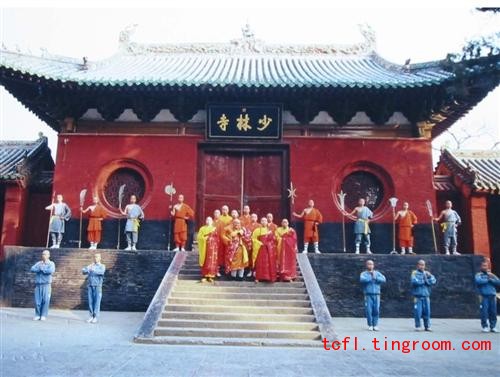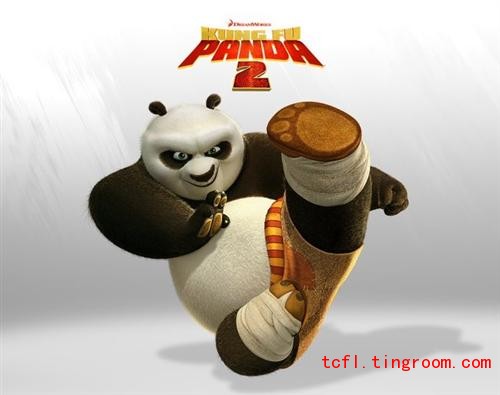Schools/ Styles
Kung Fu knows many "schools" (men [門]), "families" (jia [家]), or "sects" (pai [派]), some of which are further subdivided into styles which, for example, mimic the movements of certain specific animals, follow a certain philosophical tradition, or follow a myth or legend. Some styles lean more toward Shaolin Kung Fu while others lean more toward Wudang Kung Fu. Those that lean more toward the latter aspect of Kung Fu tap into the same kind of meditative principles as governs qigong, meaning that the practitioner of Wudang Kung Fu is very acutely aware of being in contact with his qi.

In addition to the two overarching functional distinctions of Kung Fu, there is a also northern and a southern geographical distinction that divides the discipline into a Northern School, or Style, that emphasizes lightning-fast, powerful kicks and high leaps that are spliced together speedily and seamlessly; and a Southern Style that emphasizes powerful arm and hand techniques, momentary but frozen-in-time stances, and very fast and fancy footwork that is very impressive to behold.
Both the Northern and the Southern Style can be further divided into an "external" and an "internal" variant, though it should be said that even at its "external" extreme, Shaolin Kung Fu incorporates elements of Wudang Kung Fu, else it would simply not be Kung Fu!
That is, Kung Fu rests on the interdependence of these two overarching functional aspects in much the same way that the yin and the yang are perceived as two sides to the same phenomenon, whether one is speaking of good versus evil, male versus female or even an apposition as banal as hot versus cold.
Some well-known Kung Fu styles ae Black Tiger Kung Fu, Kragon Kung Fu, Leopard Kung Fu, Shaolin Kung Fu and Snake Kung Fu.
Practical Training
The practical training of Kung Fu is a very broad topic that is too broad and detailed for us to explore in depth here. Note however that the following main elements belong to a proper Kung Fu regimen:
Basics
Basics [基本功], which include stances and conditioning exercises such as breathing, stretching, striking, leaping and throwing. Breathing exercises invoke principles of qigong, where the apprentice taps into his qi, but all movement in fact is intimately linked to one's qi, meaning that either qigong or qigong-like meditation is incorporated into the basic exercises, otherwise it is impossible for the apprentice to move with grace and fluidity.
Forms
Forms, or taolu [套路], are various sets of movements, each set consisting of a series of predetermined, coordinated movements that must be practiced until they can be executed in a single, fluid, multi-step sequence of uninterrupted segments.
It is perhaps best to think of taolu as sub-routines that are executed in response to one's opponents taolu, in much the same way that a given opening in chess generally has a finite number of corresponding counter-moves.
The apprentice begins initially learning the taolu sub-routines until he can execute them satisfactorily, then he and his teacher (or a more advanced student) hold a sparring session in which the exectution of the sub-routines are perfected. The standard for which an apprentice must strive is this: "Train your form as if you were sparring, and spar as if it were a form." What this means is that the apprentice needs to learn to recognize instantly the opponent's taolu and to immediately execute an appropriate counter taolu, as if by rote. Only then has one mastered the taolu.
Some common taolu sets are the following:
Lian quan tao [練拳套] – Fist practicing sequence,
Lian quan jiao [練拳腳] - Fists and feet practicing sequence,
Lian bing qi [練兵器] - Weapons practicing sequence,
Dui lian [對練] – Sparring sets,
Dui da [對打] – Fighting sets.
Note that the character set, 練, means "to practice" (it is present in all of the above taolu sets except for the fighting sets (dui da)), suggesting that the fighting sets are more for real than for practice. Note also that some of the taolu combat forms that one sees at special tournaments and other public displays are designed more for their aesthetics than for their practicality in an actual combat situation. Moreover, experienced masters will say that the best forms are the ones that the journeyman creates for oneself, having mastered the traditional forms contained in the "rule book".

Applications
Applications, or the practical uses of Kung Fu, involve, for the student, or apprentice, simulations of real combat situations, or sparring sets. The apprentice begins sparring with a partner who is compliant, that is, the sparring partner allows the apprentice to execute the fixed routine while countering with corresponding expected (standard "textbook") routines.
This allows the apprentice to develop proficiency in executing the given routine without having to be prepared for every imaginable contingency that might alter the routine. As time passes, the apprentice is faced with a semi-compliant opponent (some surprises are encountered, requiring the apprentice to adapt his response to these) and finally, with a non-compliant opponent, where the apprentice must respond to anything that the opponent "throws at him".
The overarching principle in simulating real combat situations via a gradual process, whereby the apprentice is faced with a more and more realistic opponent, is naturally to avoid that the apprentice suffer injury.
Some well-known sparring disciplines include the following:
Sanshou [散手], which is a freestyle type of Kung Fu that includes kickboxing, that is, Sanshou includes ti (kicks [踢]), da (punches, strikes [打]), shuai (see Shuai Jiao below) and na/ Chin Na (to lock/ to catch [擒拿/ 術])... note that na is a grappling technique where one throws one's opponent then locks his joints, while Chin Na – one of the most popular elements of Sanshou with spectators (they roar when it succeeds!) – is a special trip-up, called "kick catch", where the goal is to catch the opponent's foot during a kick and then trip the opponent up, literally, causing the opponent to lose balance and crash to the floor,
Shuai Jiao [摔跤], which is a form of wrestling that evolved from Jiao Di, or the ancient "horn butting" form or wrestling, where opponents clash and try to throw each other to the ground in the sumo manner, except that with Shuai Jiao no butting is involved and therefore there is no headgear. Shuai Jiao is closely akin to traditional Olympic wrestling as it is practiced in the West,
Wushu [武术], or standard Kung Fu, and (Chinese) Kickboxing (no Chinese translation – they use the English term instead), which is a special – very special! – variant of Sanshou where Japanese rules apply (Kickboxing is a Japanese invention whose English-language translation is as given). In fact, Kickboxing is quite different from Sanshou. It combines Western boxing, Thai boxing (Muay Thai, which includes elbowing and kneeing!) and Karate, together with kicking and punching, or Sanshou, roughly. "Anything Goes!" might be a more comprehensive description of Kickboxing!
An older form of "anything goes" Chinese boxing, called Lei Tai ("Striking Platform" [擂台], a reference to the slightly raised platform, but without ropes, on which it was fought out) where either bare knuckes, with no rules whatsoever, or where agreed-upon weapons were used existed – in China, as late as the Song (CE 960-1279) Dynasty. It was sometimes fought to the death, making the Lei Tai raised platform the Chinese answer to the Roman gladiator ring!
In addition, there are numerous other wrestling disciplines in China – often where the participants are either naked from the waist up (so that clothing doesn't provide leverage) or where they, in contrast, wear a leather jacket (to protect sensitive skin?) – that stem from the various "outer regions" of China, such as from Inner Mongolia, Xinjiang, and Shanxi, Sichuan and Yunnan Provinces.
Weapons Training
Weapons Training (qixie [器械]), is the last of the Practical Training procedures, for good reason: the apprentice – or shall we say "the adept"? – needs to be adept at all of the other aspects of Kung Fu before taking up weapons, for his own sake and for the sake of his opponent. In the hands of an adept, the weapon is simply an extension of the body. Weapons Training proceeds a bit like the training in forms, where the initial opponent – generally a teacher – is compliant, then progresses to opponents who are less compliant.
There are 18 such weapons, ranging from a simple wooden cudgel to a mace (!!!), in passing via various swords and daggers (!), axes (!!), hammers (!!!) and lances. (The story doesn't say how many apprentices perish in the making of an adept, or whether the participants wear special protective gear that prevents serious bodily harm, but if I were to go in the ring facing any one of these Eighteen Arms of Wushu, I would only do it dressed in a steel version of an austronaut's suit!)
Ethical Aspects
Lastly, Kung Fu Wushu is closely linked to a number of ethical aspects, or virtues, which, as in the ancient Japanese Samurai tradition, prevent the discipline from descending to a level 'not befitting an officer and a gentleman', one is tempted to say. In any case, the ancient masters of Kung Fu Wushu were very mindful of the necessity of following a code of honor that governed their lives both during "battle" and otherwise, especially the latter contingency.
That is, like the Samurai, the Kung Fu master did not go around full of bravado looking to pick a fight; on the contrary, the Kung Fu master was an honorable, virtuous citizen first and foremost, and a Kung Fu fighter last! The humble, long-suffering Kwai Chang Caine in the American TV series, Kung Fu, played by the Hollywood actor David Carradine, was very hard to provoke, even if, once provoked, Kwai Chang Caine could generally incapacitate his opponent before that opponent knew what hit him.

The Kung Fu tradition rests on the following ten virtues (in roughly the order of importance as listed, i.e., the first virtue being the most important): Humility, Sincerity, Politeness, Loyalty, Trust, Courage, Patience, Endurance, Perseverance and Will.
o-o-0-o-o
Kung Fu has in recent years become wildly popular in cinema, not least thanks to the so-called wuxia ("martial arts") film, Crouching Tiger, Hidden Dragon from 2000, which was a Chinese (Taiwan, Hong Kong and mainland China) and American co-production. Other well-known wuxia film include Hero (2002) and House of Flying Daggers (2004) – both by the renowned Chinese filmmaker, Zhang Yimou – and Reign of Assassins (2010), starring Michelle Yeoh.
Other internationally famous films that at least offer a nod to the wuxia genre include four Hollywood films: The Matrix (a trilogy, 1999, 2003 & 2003), Kill Bill (2003); and three French films: Le Transporteur (a trilogy, 2002, 2005, 2008) all written by the renowned writer, director and producer, Luc Besson.
In addition, there have been numerous TV series around the world that featured Kung Fu themes, including the aformentioned American TV series, Kung Fu, and, of course, Kung Fu has taken the world – or shall we say, "the universe"? – of video games by storm.
 English
English Japanese
Japanese Korean
Korean French
French German
German Spanish
Spanish Italian
Italian Arab
Arab Portuguese
Portuguese Vietnamese
Vietnamese Russian
Russian Finnish
Finnish Thai
Thai dk
dk